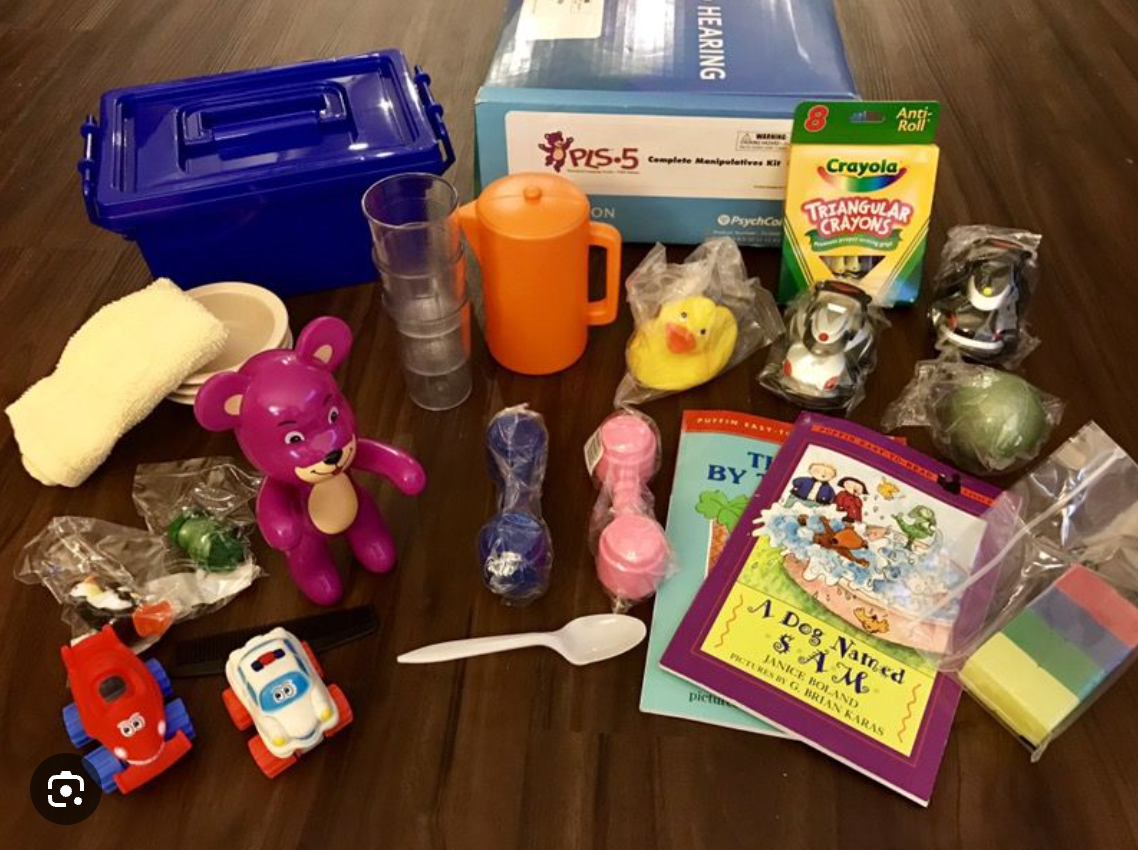Giving the Preschool Language Scales- 5th Edition (PLS-5)
The Preschool Language Scales- 5th Edition (PLS-5) is a standardized measure that is administered to evaluate the expressive and receptive language skills of a client in comparison to other children of the same chronological age. The PLS-5 is for children ages 0-7 years.

The PLS-5 is unique because it has manipulatives for a play/observational component as well as the traditional picture manual. With the play-based component, you can evaluate younger children as well as children who may have lower-level language skills and therefore may have difficulty with more formal tests like the CELF-5. There is a Spanish version as well!
PLS-5 Areas of Assessment
The PLS-5 assesses the following areas using pictures and age-appropriate manipulatives:
- Auditory Comprehension: Evaluates listening and auditory comprehension abilities of vocabulary, basic concepts, grammatical markers, comparisons, inferencing, and emergent literacy
- Expressive Communication: Evaluates expressive language abilities of naming, describing, basic concepts, grammatical markers, sentence structure, and emergent literacy
Scoring the PLS-5
The evaluator completes all sections of the assessment. Directions are given for each subtest as well as the basal and ceiling (where to start and end). The evaluator then calculates the client’s correct responses for each subtest and uses the manual to obtain a standard score for expressive and receptive language skills.
The subtest standard scores are combined and converted to a total language score, which measures overall language abilities. These scores correlate to a rating of mild, moderate, or severe.

Speech and Language Milestones
Since children develop rapidly between 0-7 years, it’s difficult to describe what a rating of mild, moderate, or severe would look like in general. So, below are speech and language milestones to reference. Children with a rating of mild may have difficulty meeting a few milestones while children with a rating of severe may have difficulty meeting more milestones.
0-12 months:
- Coos and babbles, producing a variety of sounds.
- Begins to imitate sounds and gestures.
- Responds to familiar voices and sounds.
- Understands simple words like “no” and “bye-bye.”
12-18 months:
- Says a few words, such as “mama” or “dada.”
- Uses gestures to communicate needs or desires.
- Understands simple commands and questions.
- Points to objects when named.
18-24 months:
- Vocabulary expands to around 50 words.
- Begins combining two words to form simple phrases.
- Asks simple questions using intonation.
- Uses pronouns like “me” and “mine.”
2-3 years:
- Vocabulary grows rapidly, reaching 200-300 words.
- Uses simple sentences of 3-4 words.
- Engages in short conversations with others.
- Asks “why” questions to seek information.
3-4 years:
- Sentences become more complex (4-5 words).
- Speech is mostly intelligible to strangers.
- Engages in longer conversations, sharing experiences and ideas.
- Understands concepts of time (e.g., yesterday, tomorrow).
4-5 years:
- Sentences become more grammatically correct and longer (5-6 words).
- Vocabulary expands to about 1,500 words.
- Tells stories and talks about past events.
- Follows 2-3 step instructions accurately.
5-6 years:
- Grammar and sentence structure continues to improve.
- Uses more advanced vocabulary and complex sentences.
- Participates in group discussions and expresses opinions.
- Understands and uses basic rules of conversation.
6-7 years:
- Language skills become more adult-like.
- Can engage in detailed and coherent conversations.
- Understands and uses more complex language structures.
- Reading and writing skills develop further.
For more info on report writing, check out these resources- ⬇️
Blog post: Write a Great Speech and Language Report
FREE course: Write Speech and Language Reports Like a Boss
